Robert O. Abolade, Zachaeus K. Adeyemo, Oluwasunmisayo Eleshin, Olumide O. Ajayi
Department of Electronic and Electrical Engineering, Ladoke Akintola University of Technology, Ogbomoso, Nigeria
Correspondence to: Zachaeus K. Adeyemo, Department of Electronic and Electrical Engineering, Ladoke Akintola University of Technology, Ogbomoso, Nigeria.
| Email: |  |
Copyright © 2015 Scientific & Academic Publishing. All Rights Reserved.
Abstract
Multimedia services are increasing due to necessity of life. As a result, issue of poor quality of services (QOS) and data rate need to be considered for their sustainability. The conventional Multiple Input Multiple Output (MIMO) previously in use can only improve Qos at low data rate while OFDM only reduces data rate. Therefore, this paper aims at investigating the hybridization of MIMO-OFDM with different antenna configurations over Rayleigh fading channel. The binary data are encoded by the convolution encoder. The encoded data forwarded to the mapper are being recorded by the bit inter leaver which are later converted from serial to parallel subcarriers after Quadrature Amplitude Modulation (QAM). The data from Parallel subcarriers 2, 4 and 8 are processed by Inverse Fast Fourier Transform (IFFT). Then cyclic prefix is added to prevent Inter symbol Interference (ISI). The distorted signals are received by 2, 4, 8 antennas, synchronized, cyclic prefix is removed and Fast Fourier transform processes the synchronized signals. The data through different antenna are converted to serial, demodulated and decoded after the de-interleaving. The hybridized system is evaluated using data rates and Bit Error Rate (BER) for 2x2, 4x4, and 8x8 MIMO-OFDM sectorial antenna configurations. The results obtained show that as SNR increases, the data rate also increases for both conventional MIMO and Hybridized MIMO-OFDM, but data rates for the Hybridized MIMO-OFDM are higher than conventional MIMO. Similarly, BER values for hybridized MIMO-OFDM are lower than the values obtained for conventional MIMO. This indicates that Hybrid MIMO-OFDM performs better over Rayleigh fading than conventional MIMO.
Keywords:
MIMO, LTE, OFDM, 4G, Bit Error Rate (BER), Signal to Noise Ratio (SNR)
Cite this paper: Robert O. Abolade, Zachaeus K. Adeyemo, Oluwasunmisayo Eleshin, Olumide O. Ajayi, Hybridization of MIMO-OFDM Wireless System with Different Antenna Configurations over Rayleigh Channel, Journal of Wireless Networking and Communications, Vol. 5 No. 2, 2015, pp. 67-74. doi: 10.5923/j.jwnc.20150502.03.
1. Introduction
Over the years, series of barriers have been encountered by wireless system designers in order to meet increasing demand of higher data rates, fewer dropped calls, lesser signal fading, better quality of service, higher network capacity as well as limited frequency problem [1]. More so, the availability of smart phones at cheaper prices and the continuous growth of social networking websites have led to an increase in demand for higher data rates thus requiring constant upgrading in wireless network [2]. Prior to the usage of Third generation system (3G) all over the world, the concept of wireless technology is beyond the thinking of ordinary mobile users. The high performance wireless network is achieved by combining the existing network with the new network using the core Internet protocol (IP) based network layer, thereby leading to the vision of the 4G and 5G generation [3]. The existing wireless system is developed with the aim of providing transmission rates of up to 20 Mbps with Quality of Service (QoS) features [4]. Cellular and broadband multimedia services are also offered everywhere with a data rate of up to 100 Mb/s and 1 Gb/s for outdoor and indoor communication environments respectively [5]. The wireless system supports both frequency division multiplexing (FDM), time division multiplexing (TDM) and bandwidth flexibility up to 20 MHz [6]. A multiple input multiple output (MIMO) communication system is an antenna technology which uses multiple transmitters and multiple receivers over the channel. This system exploits spatial diversity by utilizing multiple antennas at the transmitting and receiving ends of the system, to improve the performance [7]. The MIMO communication system provides high spectral efficiency and link reliability facilitating significant increase in the data throughput. This high efficiency is due to the availability of an independent path in a scattering environment [8], [9]. According to [8], MIMO channel is be transformed into an equivalent channel model using the singular value decomposition (SVD) theorem, comprising a set of uncoupled parallel sub-channels, where the number of sub-channels is given by the channel characteristics and the number of antennas employed. Though, MIMO has capability to produce spatial multiplexing gain, resulting in increased system capacity but performs poorly with high data rate.Orthogonal Frequency Division Multiplexing (OFDM) is a combination of modulation and multiplexing with high-speed transmission in wireless environment. OFDM technology is the process of dividing the high data rate into many channels known as sub-channel or subcarriers, the subcarriers are orthogonal to one another making them to have parallel transmission [10], [11]. The subcarriers have the least frequency separation needed to maintain orthogonality of their corresponding time domain waveforms. Each signal spectra corresponds to its individual subcarriers, overlap in the frequency spectra. Hence, the available bandwidth is used very effectively [12]. OFDM has already been used successfully in standards for digital audio broadcasting (DAB), terrestrial video broadcasting (DVB-T), and wireless local area networks (WLANs) [13]. Hence, it can only be used for high bit rate and not for improving QoS. This leads to the hybridization of MIMO-OFDM system.
2. System Model
The MIMO-OFDM’s system simulation model developed is shown in Figure 1. It consists of a transmitter, the Rayleigh channel and the receiver using the spatial multiplexing scheme. The number of transmitting antenna and receiving antenna is of the form NxM, where N is the number of antennas at the transmitter side and M represents the number of antennas at the receiver side. Therefore, 2x2, 4x4 and 8x8 sectorial antenna configurations are considered.  | Figure 1. The MIMO - OFDM System Model |
One thousand and twenty four bits transmitted are first sent to the convolution encoder. The encoder codes the bit received. The bit Interleaver block is used to logically record the data to be forwarded to Quadrature Amplitude Modulation (QAM) signaling scheme to modulate the signal for suitable transmission, then, the serial to parallel converter processes it to have 2,4, and 8 subcarrier known as sub channels which represent the number of transmitting antennas. The data through each carrier are processed Inverse Fast Fourier Transform (IFFT). The cyclic prefix of 16 is added to prevent Inter Symbol Interference (ISI) distortion.
2.1. Channel Matrix
The channel matrix for the different antenna configurations used is as follows:The 2x2 MIMO channel matrix H is given by: | (1) |
The 4x4 MIMO channel matrix H is given by: | (2) |
The 8x8 MIMO channel matrix H is given by: | (3) |
At the receiver, recombining signal processing techniques are implemented to retrieve the original signals.Multiple couples of data such as  are transmitted through different antenna respectively and the received signals are
are transmitted through different antenna respectively and the received signals are  Then, the relationship between transmitted and the received data through the 2,4,8 antenna configurations is as follows:For the 2x2 MIMO-OFDM the relationship is
Then, the relationship between transmitted and the received data through the 2,4,8 antenna configurations is as follows:For the 2x2 MIMO-OFDM the relationship is  | (4) |
For the 4x4 MIMO-OFDM the relationship is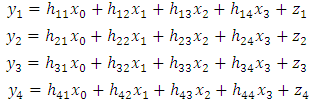 | (5) |
For the 8x8 MIMO-OFDM the relationship is | (6) |
 | (7) |

2.2. OFDM Signal
The output signal of the IFFT gives an OFDM signal in time domain and the signal is represented as in equations (8) and (9) | (8) |
For  where
where  is 2x2, 4x4, and 8x8 representing the number of subcarriers in this paper and each consisting of symbol
is 2x2, 4x4, and 8x8 representing the number of subcarriers in this paper and each consisting of symbol  .The addition of 16 cyclic prefix gives the receiver perfect time synchronization. Hence, the transmitted signal is expressed as:
.The addition of 16 cyclic prefix gives the receiver perfect time synchronization. Hence, the transmitted signal is expressed as: | (9) |
The corresponding index value from each sequence is arranged in 2x2, 4x4 and 8x8 code matrix forms. Code matrix X is multiplied by the channel matrix H with Additive White Gaussian Noise (AWGN) z added to obtain the output signal Y at the receiver. This is expressed by the equation (10): | (10) |
where n is the discrete-time index,  is the column vector whose components are complex symbols belonging to an elementary two-dimensional constellation (QAM).
is the column vector whose components are complex symbols belonging to an elementary two-dimensional constellation (QAM).  is a matrices describing the channel impulse response,
is a matrices describing the channel impulse response,  is the Additive White Gaussian Noise (AWGN) and
is the Additive White Gaussian Noise (AWGN) and  is the received signal.
is the received signal.
3. Simulation Parameters
The simulation parameters used in this work are presented in Table 1.Table 1. Simulation parameters
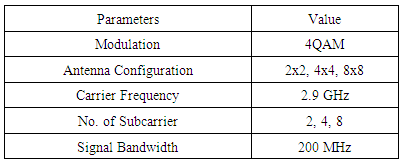 |
| |
|
3.1. Data Rates (DR) and Bit Error Rate (BER)
3.1.1. Data Rate
The data rate is the number of bits processed per unit time usually in bit/sec. | (11) |
The data rates for 2x2, 4x4 and 8x8 MIMO-OFDM in wireless channel are calculated using equation (11).
3.1.2. Bit Error Rate (BER)
In digital transmission, the number of bit errors is the number of bits received that have changed over a communication channel due to noise, distortion, fading, interference or bit synchronization redundancy.In other words, bit error rate or bit error ratio (BER) is defined as the ratio of the erroneous bits received over the transmitted bits in a transmission system during a studied time interval. BER is a unit less quantity, often expressed as a percentage or 10 to the negative power. | (12) |
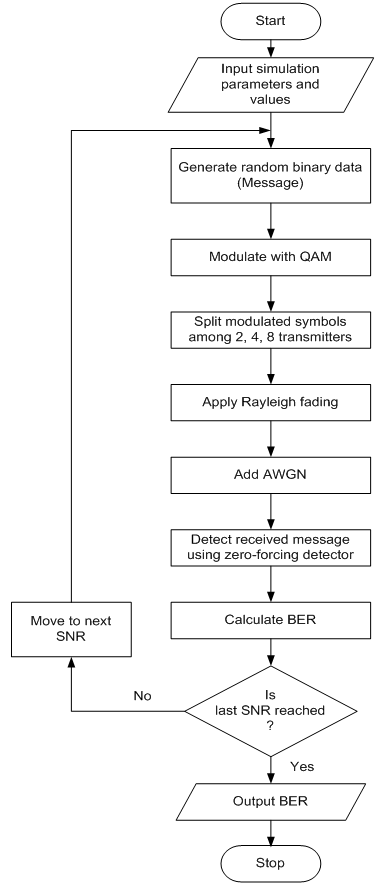 | Figure 2(a). Flowchart of the MIMO over Rayleigh channel |
3.1.3. Signal to Noise Ratio (SNR)
The SNR is the ratio of the received signal power over the noise power in the frequency range of the process. SNR is inversely related to BER, that is, high BER results in low SNR. High BER causes an increase in packet loss, enhance in delay and decrease throughput. SNR is an indicator which usually measures the clarity of the signal in a wired/wireless transmission channel and measured in decibel (dB). The SNR is the ratio between the wanted signal and the unwanted background noise. The equation is given as: | (13) |
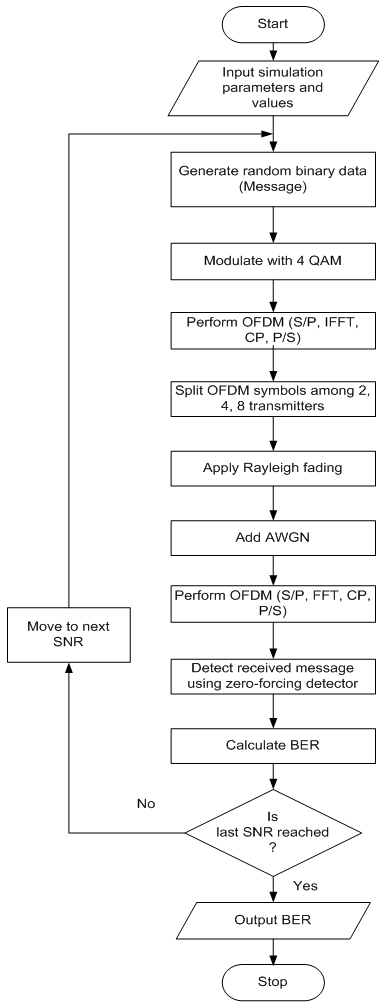 | Figure 2(b). Flowchart of the simulation process for MIMO-OFDM |
4. Results and Discussion
The performance of the hybridized MIMO-OFDM system in 4G network has been evaluated using computer simulation in terms of data rate and BER for 2x2, 4x4 and 8x8 antenna configurations.The data rate results are presented in Figures 3 and 4 for conventional MIMO and hybridized MIMO-OFDM with 2x2, 4x4, and 8x8 antenna configurations. Figure 3 shows that at SNR of 2dB, 8dB and 10dB, the data rates of 16.37Mbit/s, 48.08Mbit/s and 57.56Mbit/s are obtained for conventional 2x2 MIMO as against 53.05Mbit/s, 184.61Mbit/s and 225.6Mbit/s obtained for 4x4 MIMO respectively while 219.8Mbit/s, 710.1Mbit/s and 867.8 Mbit/s are obtained for conventional 8x8 MIMO respectively. Figure 4 shows that the data rates obtained at SNR of 2dB, 8dB and 10dB are 49.15Mbit/s, 149.76 Mbit/s and 180.23 Mbit/s for hybridized 2x2 MIMO-OFDM system in 4G Networks over Rayleigh fading channel as against 196.6Mbit/s, 580.9Mbit/s and 720.09Mbit/s obtained for4x4 MIMO-OFDM system while 786.5 Mbit/s, 2359.4Mbit/s and 2797.7Mbit/s data rates are obtained for 8x8 MIMO-OFDM system respectively. These same results are presented in Table 2 for clarity and comparison purpose.The BER results for both conventional MIMO and hybridized MIMO-OFDM systems in 4G with 2x2, 4x4 and 8x8 antenna configurations over Rayleigh fading channel are presented in Figures 5 and 6. Figure 5 shows that at SNR of 2dB, 8dB, and 10dB, the BER values of 0.0706, 0.0227 and 0.0137 are obtained for conventional 2x2 as against 0.0347, 0.0123, and 0.0095 obtained for 4x4 MIMO respectively while 0.0168, 0.0045 and 0.0032 are obtained for conventional 8x8 MIMO respectively. Figure 6 shows that the BER values obtained at SNR of 2dB, 8dB and 10dB for hybridized 2x2 MIMO-OFDM systems are 0.0026, 0.0010, 0.0006 as against 0.0026, 0.0009 and 0.0005 obtained for 4x4 MIMO-OFDM system in 4G respectively. The BER values for other SNRs are contained in Table 3. The results show that as SNR increases, the BER value reduces for both conventional MIMO and hybridized MIMO-OFDM system in 4G technology, when the antenna configuration increases, the BER value decreases for both techniques. The BER values obtained for MIMO-OFDM are lower than conventional MIMO indicating good performance. The results obtained are justifiable because of the incorporation of the OFDM which takes care of high data rates without any distortion. The high data rates are split into 2, 4, 8 subcarriers to have parallel channel to avoid inter symbol interference distortion which is likely to occur with conventional MIMO technique which eventually reduces the data rate.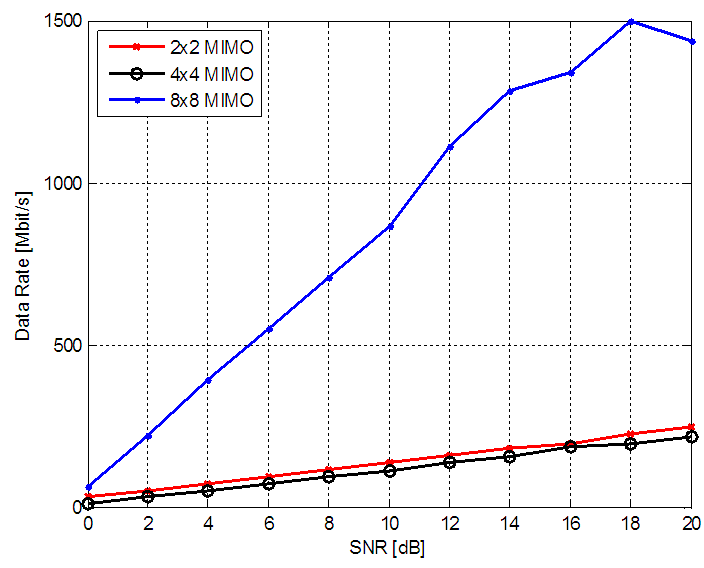 | Figure 3. Data rates versus SNR for conventional MIMO with different antenna configurations |
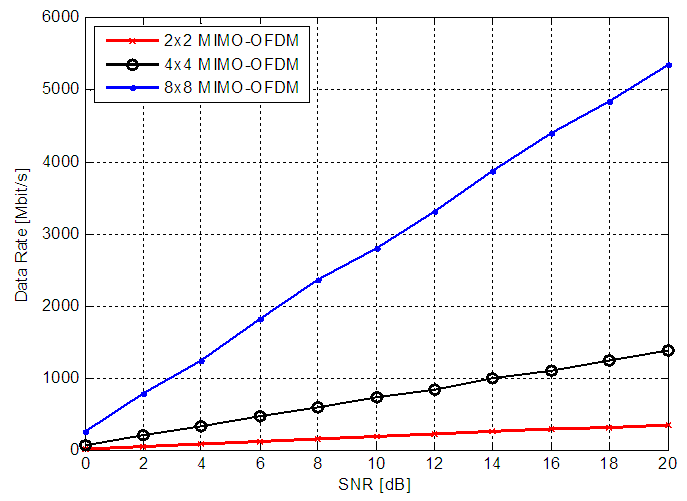 | Figure 4. Data rates versus SNR for MIMO-OFDM with different antenna configurations |
 | Figure 5. BER versus SNR for conventional MIMO with different antenna configurations |
 | Figure 6. BER versus SNR for MIMO- OFDM with different antenna configurations |
Table 2. Data rate values for conventional MIMO and MIMO-OFDM systems with different antenna configurations
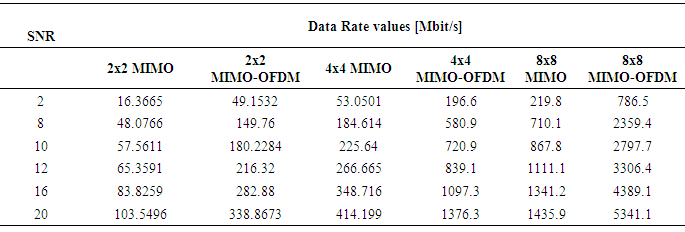 |
| |
|
Table 3. BER results at different SNR for MIMO-OFDM and MIMO systems with different antenna configurations
 |
| |
|
5. Conclusions
In conclusion, the hybridization of MIMO-OFDM wireless system with 2x2, 4x4, and 8x8 antenna configurations over Rayleigh fading channel has been developed, evaluated using data rate and BER. The system model that represents the physical phenomenon of the hybridized MIMO-OFDM system has been developed around a transmitter which consists of convolution encoder, interleaver, QAM modulator, serial to parallel converter, inverse fast fourier transform, cyclic prefix, different antenna configurations. The Rayleigh fading channel with AWGN is used as wireless channel to form the faded signal. The faded signal output of the channel serves as input to the transmitter which consists of 2, 4, and 8 receive antenna, synchronized for proper synchronization, cyclic prefix removal, fast fourier transform, parallel to serial converter, QAM demodulator, de-interleaver and decoder, all for proper processing to retrieve the signal. The results obtained show that as SNR increases, the data rate also increases for both conventional 2x2, 4x4, 8x8 MIMO and hybridized MIMO-OFDM antenna, but the hybridized MIMO-OFDM system has higher data rate than conventional MIMO. Similarly, BER values for the hybridized MIMO-OFDM are lower than the values obtained for the conventional MIMO indicating better performance in 4G than conventional MIMO. Also, as the number of antenna configuration increases, better performance is observed. This paper has shown that hybridization of MIMO-OFDM in 4G system reduces the errors which can hinder the quality of service in the faded environment.
References
| [1] | Pravin, W., Raut, S.L., Badjate, 2013, MIMO- Future Wireless Communication, International Journal of Innovative Technology and Exploring Engineering, 2(5), 102-104. |
| [2] | Muhammed, M., Khalid, K., and Muhammed, U., 2012, LTE-Advanced: Requirements and Challenges for 4G Cellular Network, Journal of Emerging Trends in Computing and Information Science, 3(5), 665-670. |
| [3] | Piyush, G., Priyadarshan, P., 4G- A New Era in Wireless Communication, Magister Program in Software Engineering, Malardalen University, 1-2. |
| [4] | Simon, H., 2011, Evolution of Mobile Technology. Available from http://www.brighthub.com/mobile/emergingplatforms/articles/30965.aspx, Retrieved on 1st December, 2011. |
| [5] | Khaleel, A., Sunil, K., and Jayant, S., 2012, Network Congestion Control in 4G, Technology through Iterative Server, International Journal for Computer Science 9(4,2), 1-4. |
| [6] | Ian, F., Akyildiz, D. M., Gutirerrez, E., Elias, C. R., 2010, The Evolution of 4G Cellular Systems: LTE-Advanced, Broadband Wireless Networking Laboratory, School of Electrical and Computer Engineering, Georgia Institute of Technology, Atlanta, USA, 217-244. |
| [7] | W. Mattias, On MIMO systems and Adaptive Arrays for Wireless Communications, Analysis and Practical Issues, Ph.D. thesis, Signals and Systems, Uppsala University, Uppsala, Sweden, 2002. |
| [8] | Maneesha, S., 2014, Effective Channel State Information (CSI) Feedback for MIMO Systems in Wireless Broadband Communication, School of Electrical Engineering and Computer Science, Queensland University of Technology, 2014. |
| [9] | Abdelhakim, K.., and Ridha, B., 2011, Performance Analysis of LS and LMMSE Channel vol.3, no.5, pp. 141-142 |
| [10] | Md. M. H., Mohammad, S. R. and Ki-Doo Kim, Performance Analysis for MIMO-OFDM for 4G Wireless Systems under Rayleigh Fading Channel, International Journal of Multimedia and Ubiquitous Engineering, vol.8, no.1,pp. 14-15, 2013. |
| [11] | A. Vinoth, D. Jotheeswaran, Analysis of the 4G Technologic Requirement and Key Technology, 2nd International Conference in Emerging Trends in Informative Computing Application proceeding, published by International Journal of Computer Applications, pp.16-18, (2012). |
| [12] | Lavish, K., 2011, Performance Analysis for 8X8 MIMO-OFDM System using QOSTBC under Different Fading Channels for Higher Order Modulation, Department of Electronics and Communication Engineering, Thapar University, Punjab, India. |
| [13] | A. Lodhi, F. Said, M. Dohler and A. H. Aghvami, Performance comparison of space-time block coded and cyclic delay diversity MC-CDMA systems, IEEE Wireless Communication, vol.12, no2, pp38-45, 2005. |
| [14] | Z. K. Adeyemo, O. O. Ajayi, R.O. Abolade, Effect of OFDM Transmission Mode on Frequency Synchronization Performance, International journal of engineering research and applications (IJERA), vol.3, no 2, March-April (2013). |





 are transmitted through different antenna respectively and the received signals are
are transmitted through different antenna respectively and the received signals are  Then, the relationship between transmitted and the received data through the 2,4,8 antenna configurations is as follows:For the 2x2 MIMO-OFDM the relationship is
Then, the relationship between transmitted and the received data through the 2,4,8 antenna configurations is as follows:For the 2x2 MIMO-OFDM the relationship is 





 where
where  is 2x2, 4x4, and 8x8 representing the number of subcarriers in this paper and each consisting of symbol
is 2x2, 4x4, and 8x8 representing the number of subcarriers in this paper and each consisting of symbol  .The addition of 16 cyclic prefix gives the receiver perfect time synchronization. Hence, the transmitted signal is expressed as:
.The addition of 16 cyclic prefix gives the receiver perfect time synchronization. Hence, the transmitted signal is expressed as:

 is the column vector whose components are complex symbols belonging to an elementary two-dimensional constellation (QAM).
is the column vector whose components are complex symbols belonging to an elementary two-dimensional constellation (QAM).  is a matrices describing the channel impulse response,
is a matrices describing the channel impulse response,  is the Additive White Gaussian Noise (AWGN) and
is the Additive White Gaussian Noise (AWGN) and  is the received signal.
is the received signal.








 Abstract
Abstract Reference
Reference Full-Text PDF
Full-Text PDF Full-text HTML
Full-text HTML

